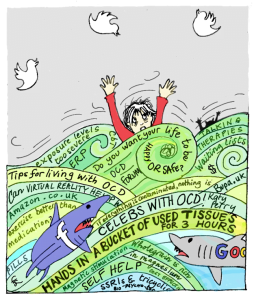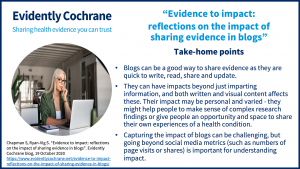20th October is World Evidence-Based Healthcare Day. Cochrane UK’s Knowledge Brokers, Sarah Chapman and Selena Ryan-Vig, take up its theme #EvidenceToImpact, with a reflection on the potential impact of sharing evidence in blogs and the challenges of capturing it.
Page last checked 26 June 2023
Take-home points
For this first World Evidence-Based Healthcare Day, organisations and individuals are being asked to share their experiences regarding the impact of their work in evidence-based health care. At Cochrane UK, we share health evidence (mostly from Cochrane ReviewsCochrane Reviews are systematic reviews. In systematic reviews we search for and summarize studies that answer a specific research question (e.g. is paracetamol effective and safe for treating back pain?). The studies are identified, assessed, and summarized by using a systematic and predefined approach. They inform recommendations for healthcare and research.) on several social media platforms and in a variety of formats, much of it intended for patients and others making health decisions, and health professionals. We also aim to help people understand the principles underpinning evidence-based health care. One of the main ways we do these things is through our Evidently Cochrane blogs. These are published weekly, at a minimum, with extra blogs when evidence is published that we want to share quickly, or when we have a special series of blogs on one topic.
While there are clear ways of demonstrating the impact of Cochrane Reviews, such as their inclusion in guidelines, capturing the impact of our work to share evidence from these reviews can be difficult. This feels like a good moment to reflect on a couple of key questions, discussed here in relation to the blogs but pertinent for all our dissemination work. What can we do to increase the likelihood that people will see what we share, understand and engage with it, and hopefully use it to inform their health decisions? How can we capture something of this?
Numbers
Generating some numbers as indicators of impact is an easy thing. We can tell, for example, when we post a summary of a Cochrane Review on Figure 1, an app for healthcare professionals which is heavily used in North America, how many times it is viewed (typically a number in the 1000s within the following few days). We can see how many times a blog is viewed and the average time spent on that page. When we share them on social media, we can collect numbers of tweets ‘liked’ or retweeted, followers gained, and so on. But whilst this is all well and good, what does this tell us? Not very much – and not whether the evidence that is passing someone’s eyes is having any impact upon them at all (other than to hit ‘like’ perhaps). A retweet doesn’t tell us if someone has actually read what they’re sharing. If they read it and understand it, as we hope, does it influence what they do? This is key, but oh so hard to capture.
Blogs: quick to write, read, share and update
One of the main benefits of blogs as a way of sharing evidence is that they can be written, shared and read quickly. We ensure ours remain current by updating them when the evidence they include is updated. This has proved to be really useful this year, as Cochrane has rapidly produced, and updated, summaries of research relevant to the COVID-19 pandemic and we have been able to get this to our audiences in a useful and timely way.
We have been encouraged by occasional feedback – both comments on the blog and social media – that our COVID blogs have been “really helpful”, and have offered “great clarity”. The viewing figures also suggest that these blogs are addressing questions that people are keenly seeking answers to. The blog “Antibody tests for COVID-19: new evidence on test accuracy and some considerations”, for example, quickly became the 5th most viewed page on Evidently Cochrane this year.

Evidence and experience
Evidently Cochrane blogs often explore the potential impact of Cochrane evidenceCochrane Reviews are systematic reviews. In systematic reviews we search for and summarize studies that answer a specific research question (e.g. is paracetamol effective and safe for treating back pain?). The studies are identified, assessed, and summarized by using a systematic and predefined approach. They inform recommendations for healthcare and research. by inviting people with relevant expertise to reflect on it in the context of their personal or professional experiences. What does the evidence look like from the perspective of someone who has that condition, who perhaps is weighing up whether to have the treatmentSomething done with the aim of improving health or relieving suffering. For example, medicines, surgery, psychological and physical therapies, diet and exercise changes. it assesses, or maybe has had it? Or it might be a family member or a health professional, for whom the evidence is potentially relevant. Does it tell them what they want to know? Have the researchers asked the right questions? Have they looked for the effects of the treatment on things that are important to patients? What important evidence gaps are revealed, and uncertainties still to be addressed – both by the people using it to make decisions and by researchers?
By sharing evidence and experience together, these blogs can do several things:
Go beyond the evidence to ‘What happened next?’
‘More research needed’ is a frustrating thing to read, but often Cochrane Reviews identify evidence gaps. Blogs provide an opportunity to share, alongside these, news of ongoing research, sometimes directly related to gaps in the evidence found by the review authors. Nurse and Cochrane review author Tracie Miles wrote in her blog Vaginal dilator therapy: vibrate, dilate, or wait? about the evidence gap, what was happening in practice, what she heard from the women in her care and what happened next. This offers something more informative and more constructive than simply saying that ‘more research is needed’.
Show how people have used evidence to help them make health decisions
These are also blogs that tell us what happened next, but in a personal context. Sharing stories of how someone has used evidence in their real-life situations can be really relatable and engaging. Blogs like Karen Morley’s My OCD story: evidence-based medicine to the rescue! in which she talks about seeking help for her Obsessive-Compulsive Disorder (OCD) and how finding and using Cochrane evidence was a turning point. Some of our blogs now include prompts for questions readers might want to think about and discuss with their clinician. Such as those suggested by former GP Lynda Ware, in her blog Speaking with your healthcare provider about treatment decisions: Q&A with a former GP.
Reach people through shared experience
We are very thankful to all our bloggers for giving their time and expertise. When this involves sharing experiences relating to their own health, or that of someone close to them, we are conscious of our responsibilities not just to represent the evidence accurately but to treat these personal stories with great care and respect. We have been entrusted with something fragile (this excellent blog, which we’re so pleased to have, could be about someone’s worst life experience…), but also something powerful. Some blogs stop us in our tracks when we are sent them, and reading them if it has echoes of your own story must be even more arresting.
Some readers leave questions and comments on the blog, often generating a response from the blogger or others, and some find something in them that moves them to share their own stories there. In the blog Pregnancy after stillbirth: experience and evidence gaps an exploration of the state of the evidence is followed by Susannah Leisher’s moving account of her experiences when her first son Wilder was stillborn, and afterwards. Since its publication, so many bereaved mothers have posted below it their stories of the stillbirth of their babies. Susannah has replied to each one. Some have questions for her, some remark on what the blog has given them (hope, comfort, the help that comes from knowing they are not alone), and all want to tell their stories.

Experiences shared can provide rich learning for health professionals, as well as reaching others who have been through similar experiences. Another good example is this blog Living and dying well after stroke, which has also attracted many people to share really hard personal experiences. These comments give us some indication of blog impact, but we feel we could learn more from them, and that this might help us understand better how we can serve our audiences. To this end, we are about to embark on some qualitative research to explore the comments from the five blogs that have attracted the most comments, with care taken to preserve the anonymity of those who have commented. We will share updates on this work as it progresses.
Stimulate discussion and behaviour change
Sometimes our blogs can generate discussion online, including through discussions on Twitter. These can both increase the impact of the blogs and sometimes demonstrate their impact, giving us a rare glimpse of how sharing evidence in this way can prompt behaviour change. Our special series ‘The Problem With Sex’ encouraged discussion of a difficult subject, which was warmly welcomed, and we heard of instances of change to information provided to patients as a result. We will be hosting a discussion on Twitter on 12th of November on the topic of ‘communicating about cancer’ as part of our cancer special series next month and publishing blogs on this theme, so do look out for those.
Images have impact
If our content has the potential to impact readers in a positive way, it also has the potential to have a negative impact, if we get it wrong. Earlier this year, we had a discussion on Twitter about illustrating mental health topics. One researcher explained that young people who’ve worked with Cochrane Common Mental Disorders have said that images triggering negative feelings can make them feel more vulnerable, more isolated and perhaps more reluctant to seek help. On the contrary, images demonstrating strength and resilience might challenge stigma and, potentially, encourage help-seeking behaviour. We have a responsibility to make careful, thoughtful image choices and, in doing so, we can help to have a positive influence on conversations around health issues. Our new resource Choosing images for sharing evidence: a guide acknowledges that the images we choose matter and addresses some of the risks and opportunities of choosing images.

From evidence to impact
Ultimately, all of us working to share evidence want to know that our work is having a positive effect. The impact of our blogs – although difficult to grasp – can be manifold. A blog might give people an opportunity and space to share their own experiences of a health condition, or to feel less alone in knowing that there are others out there facing similar dilemmas. It might help people to make sense of findings, or equip individuals with questions and considerations to explore during a discussion with a clinician. Only by looking past the viewing figures, can we gain a sense of this. Trying to capture the impact of the blogs, and our other dissemination products, is to chase a rather elusive quarry, but it’s important if we are to use our resources wisely and serve our readers as well as we possibly can. How are others doing it? We’d love to hear!
Join in the conversation on Twitter with @CochraneUK and @SarahChapman30 or leave a comment on the blog. Please note, we will not publish comments that link to commercial sites or appear to endorse commercial products. We welcome diverse views and encourage discussion but ask that comments are respectful and reserve the right to not publish comments we consider offensive.
Sarah Chapman and Selena Ryan-Vig have nothing to disclose.




[…] studies and empirical evidence support the claim that Pilates can lead to noticeable improvements in various postural issues, including […]